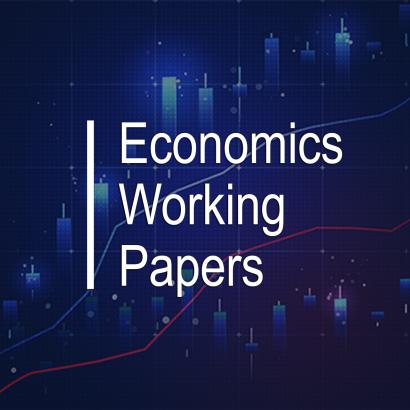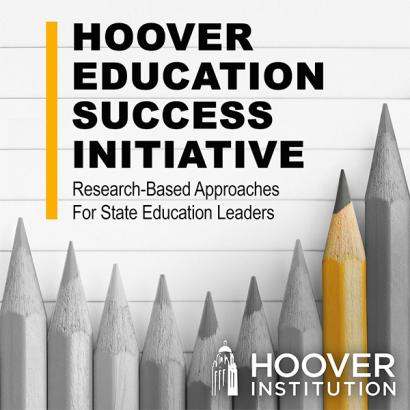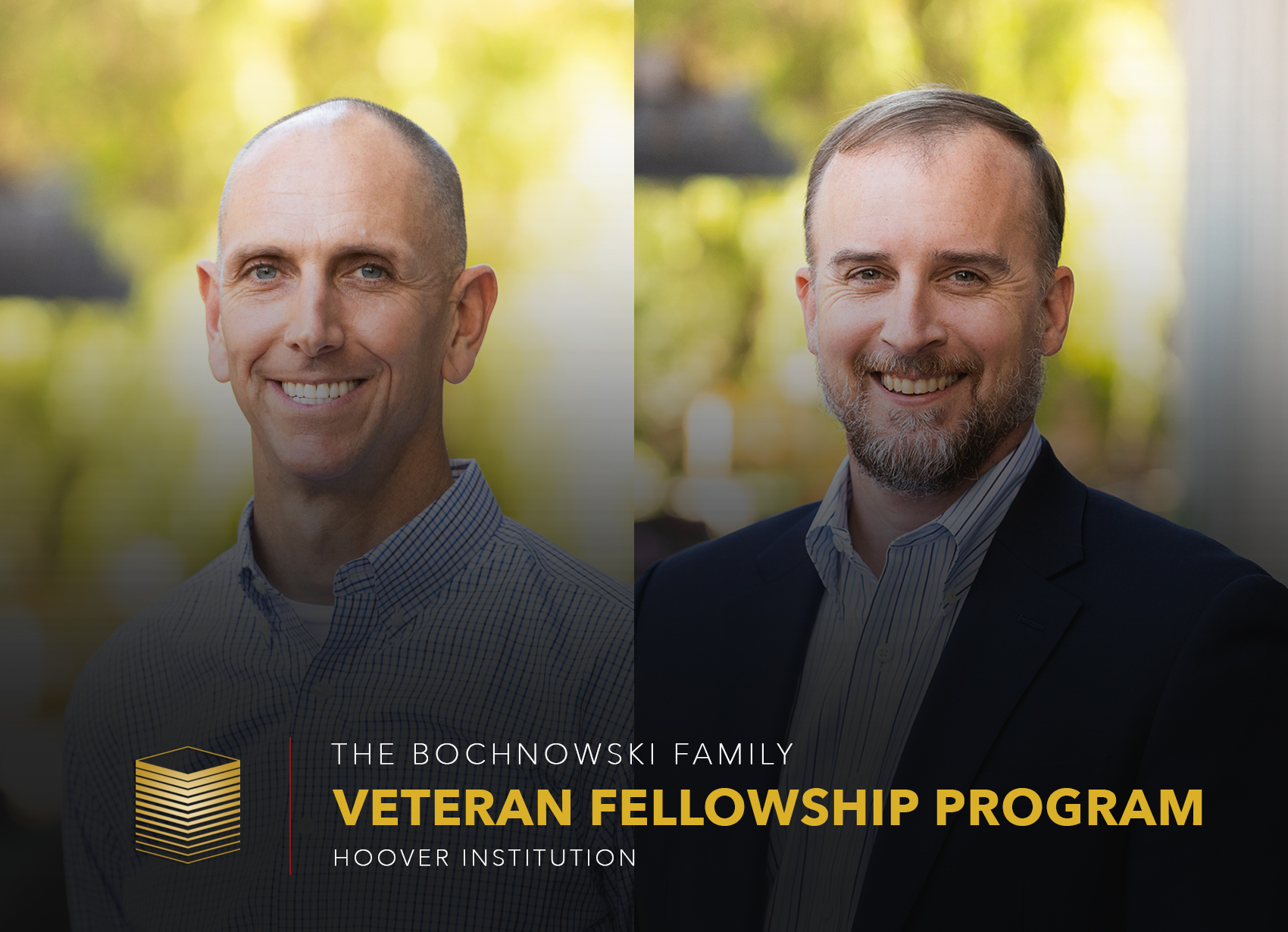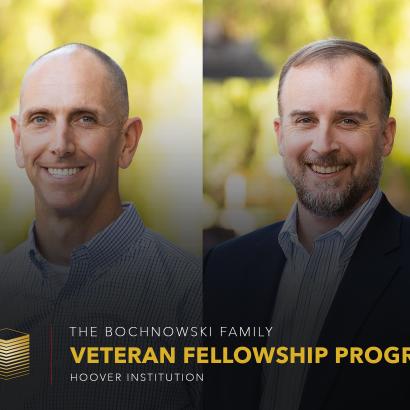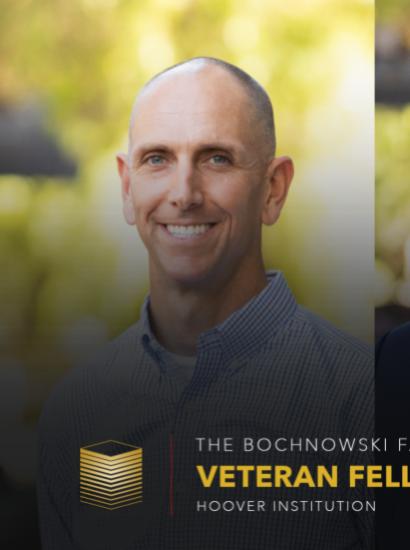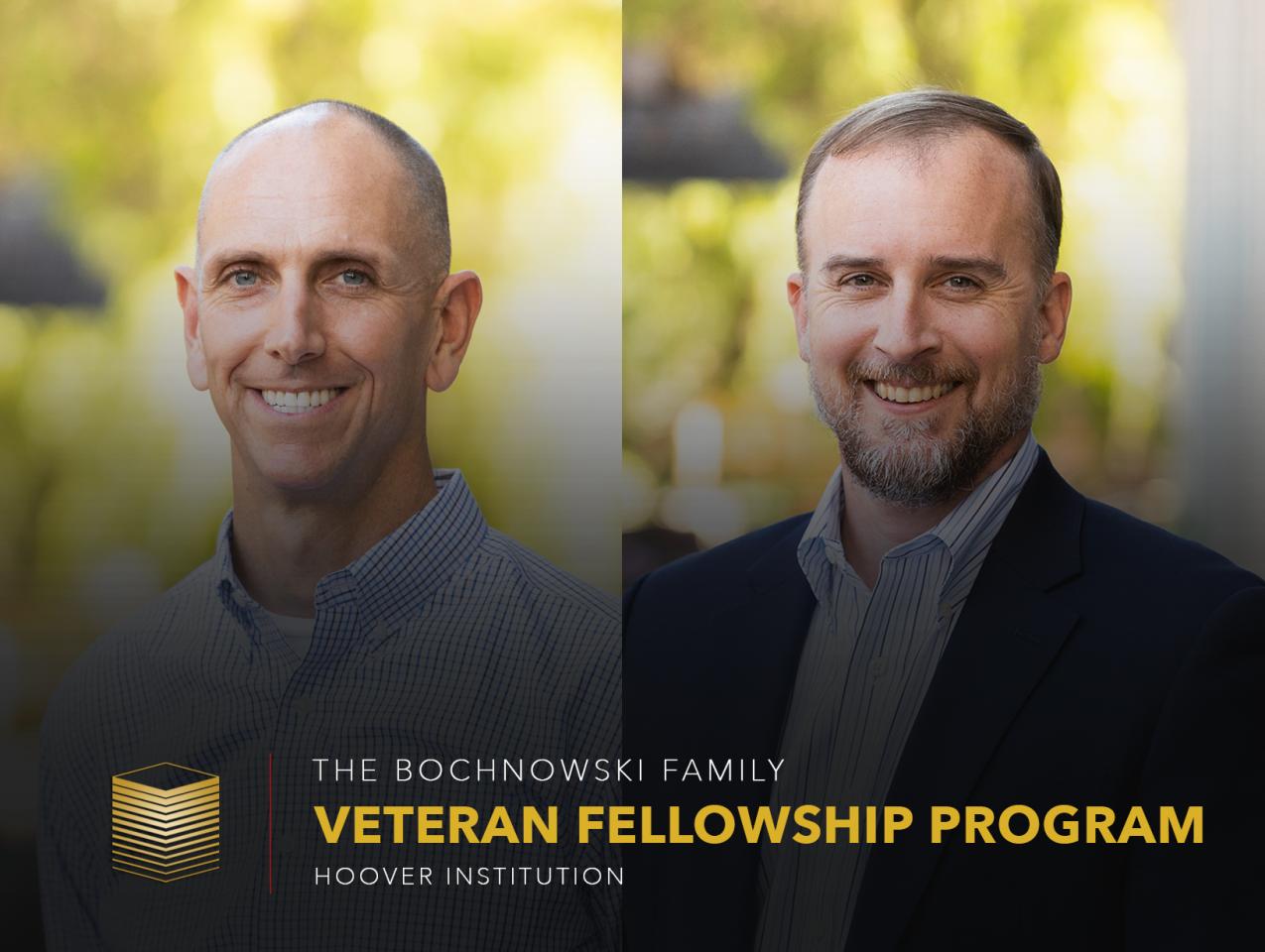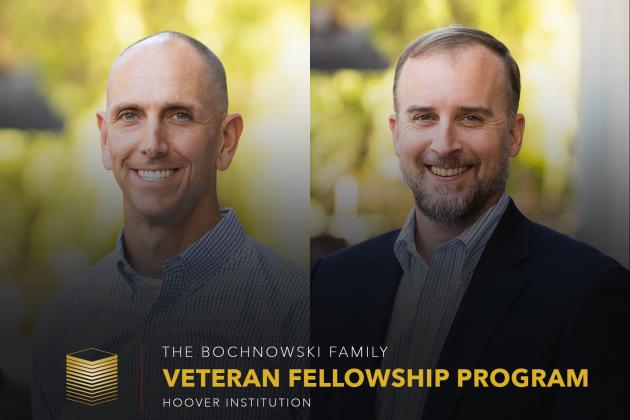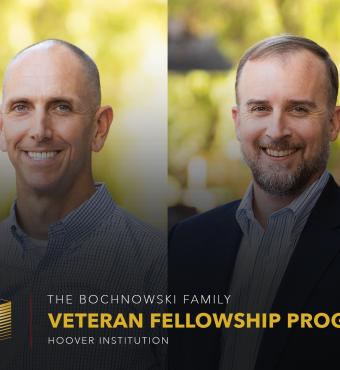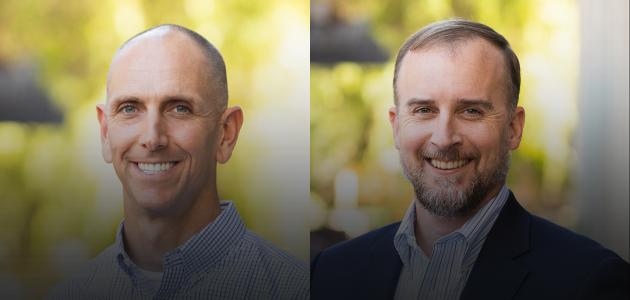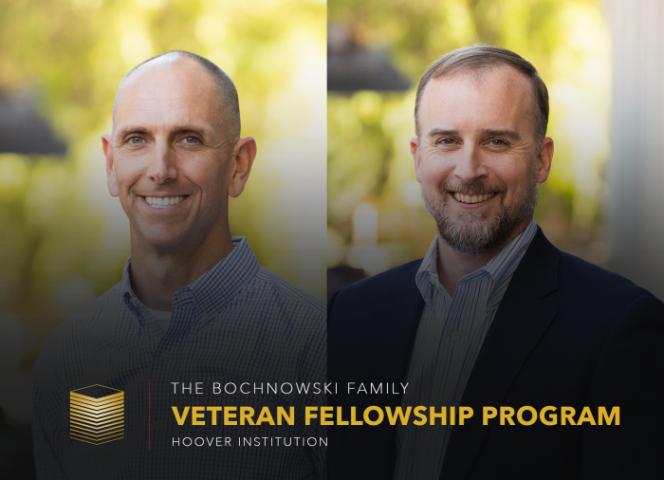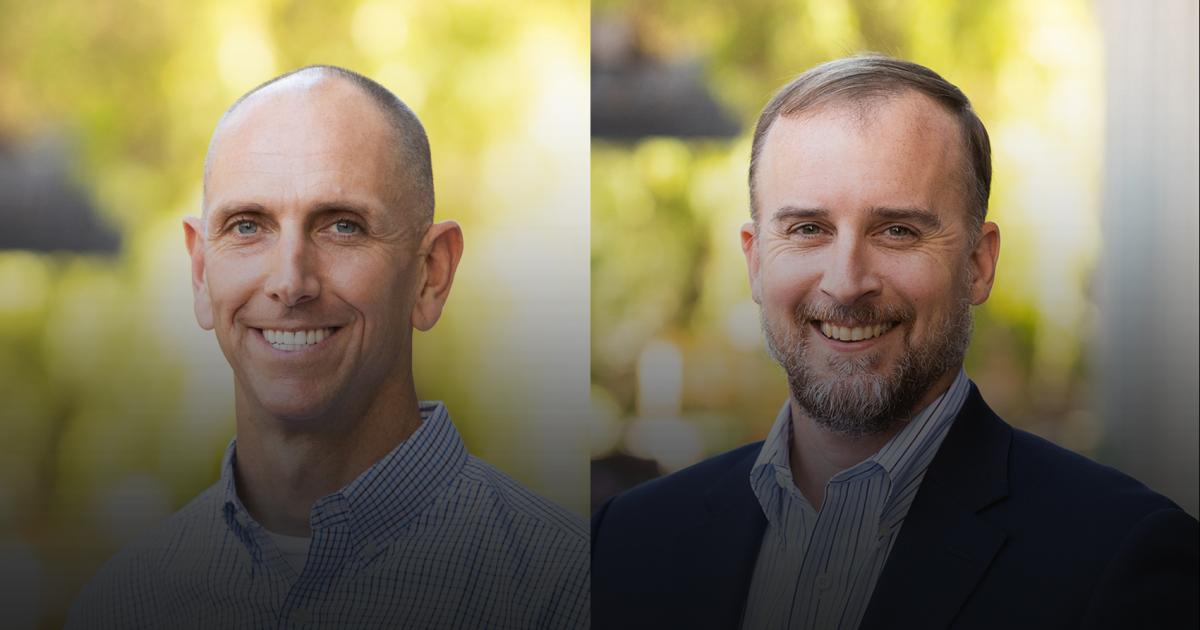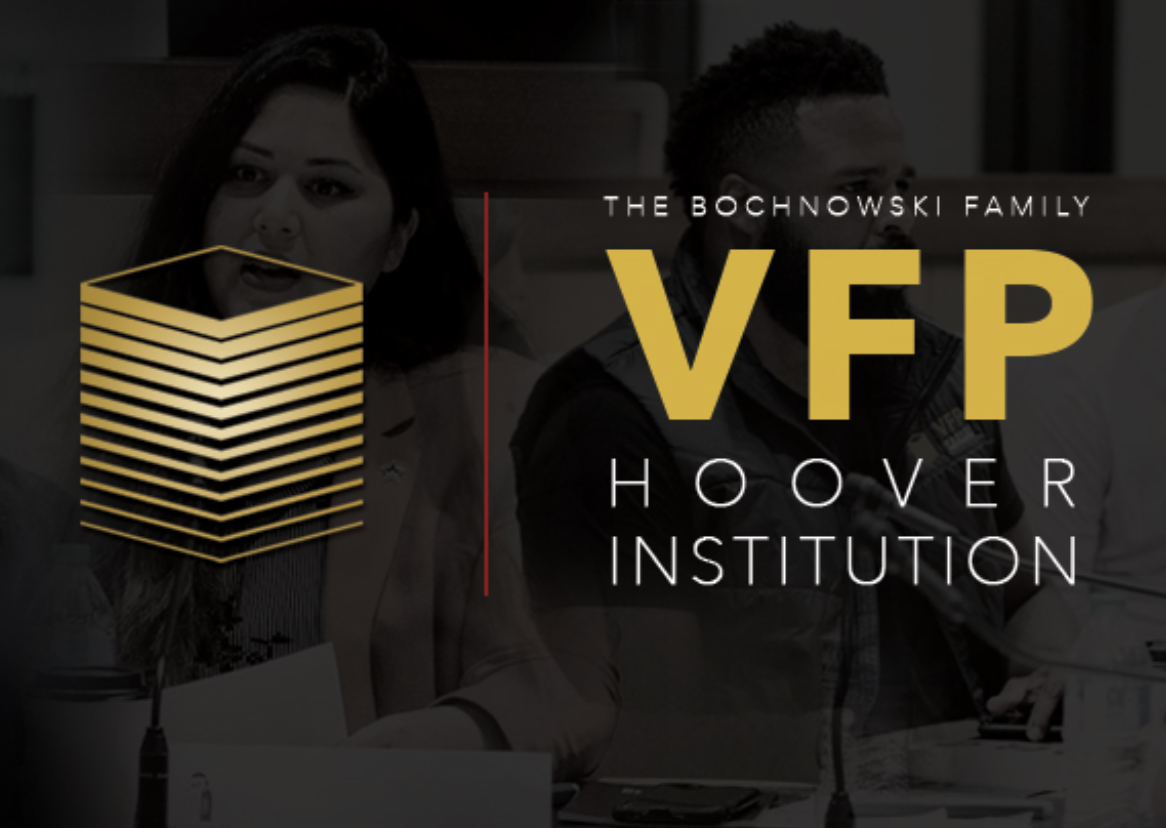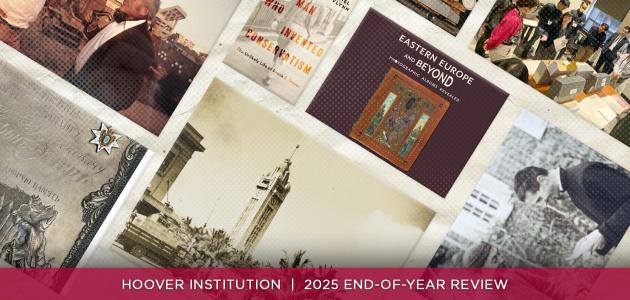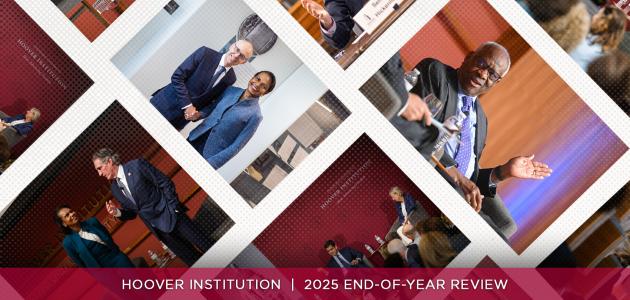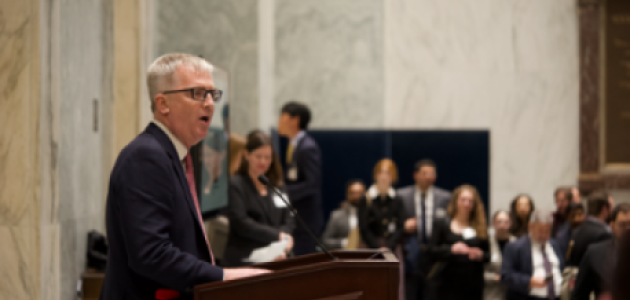Donnie Hasseltine and Dave Winnacker were part of the first-ever cohort of Hoover’s Veteran Fellowship Program from 2021 to 2022. They worked together to build XyloPlan and Zonehaven (now part of Genasys Project Evac), applications to help prepare communities and develop mitigations against forest fires. They spoke to Chris Herhalt about how their service in the Marine Corps, their year at Hoover, and their own partnership together allowed them to build these new tools.
Apply to join the 2025–26 cohort of Hoover’s Veteran Fellowship Program here.
Chris Herhalt: So, Donnie, Dave, thank you so much for taking some time to join me. I want to talk to you a little bit about the Hoover Veteran Fellowship program. And I want to start out with asking each of you what your project or area of focus was in your year.
Dave Winnacker: Yeah, we’re unique in that regard in that we came at this together, applied separately, but working on a single project.
And our project really leveraged a couple of things. One, my career as a firefighter and specifically as the fire chief of a local agency in the Bay Area. And the connection that Donnie and I served together, and we spent a fair amount of time just sort of noodling or picking at the wicked problem of wildfire loss, which was front of mind after the North Bay fires in 2017.
And we were really experimenting on the whiteboard with okay, legacy approaches to fires aren’t working. Where are the gaps? What is the optimal route? And then what does that look like when it is divided against what is possible? You know, pragmatically, what could we do? And really started approaching it as an interesting problem using Marine Corps planning processes that we were familiar with that had context where we were spending time together.
And that was the basis of our proposal, which was understanding where there are market forces that can be brought to bear to accelerate the transition to a fire-adapted future. And where there are regulations, policies, subsidy programs, et cetera, that are buffering communities from exposure to those market forces.
Really there are abstraction layers that are separating people from an accurate pricing of their risk, both risk baseline and mitigated risk after measures have been taken. And that’s really where we spent our time, anchoring on what the underlying issue is: how bad is it and what is being done, often with good intent, to create separation between people and the pricing of the [fire] risk. On our theory that market forces will be the primary driver of adaptation, uptake of change. We largely know what needs to be done. That’s my lane. We don’t know how to get people to do it. And that was really where our focus was.
Donnie Hasseltine: Obviously when Dave and I were both in [service], I was the active-duty counterpart to his reserve position at 23rd Marine Regiment and I was in the process of going through a technical master’s degree program. I was also working at Stanford’s Hacking for Defense Program as a team mentor. And that was exactly kind of the genesis, “Hey, we’re fighting fires like we did one hundred years ago, why aren’t we using the technology and financial incentives and resources in Silicon Valley towards that?”
So that got us to sketch out a lot of ideas. But some of those ideas have kind of taken root. You mentioned Zonehaven and things like that kind of grew out of that. But about a year or so later, I was now out in private equity, Dave was still the fire chief of Moraga-Orinda.
And the question with Hoover came, as Dave just put it—it’s like we know how to stop fires from spreading through communities. There is science that defines that, but people are not doing that (installing fire mitigations in their communities). So how do we do that?
And there’s a couple different ways you can do that. We looked at our stakeholders as fire professionals, local residents, and government while trying to look at how those different pieces intersected. You know, you can go write tickets all you want, you can pass laws all you want, you can do other things to try to compel people. But the best way to get them to (introduce fire-mitigating measures) is if they want to do it on their own initiative. And where there's a self-interest, research has found that the best solutions are market-based solutions. If you looked at the insurance industry, for example, you could see the home insurance industry was starting to collapse.
The research we did with the California FAIR [Fair Access to Insurance Requirements] Plan back several years ago has now borne out in spades here. But one of the things government does poorly is insurance, right? You can look at my own state of Louisiana and flood insurance, see how that came about, that it’s going to be expensive and it’s not going to be very effective insurance.
So, folks are being driven to that FAIR Plan, effectively losing insurance or just being non-renewed. And in those cases, they really had no options available to them. So, if there’s a way to show new science to say, ‘hey, you’re about to lose your insurance or your only option, the FAIR Plan,’ but if you take these clear mitigation steps, now we can kind of circle that back through catastrophic risk modeling. And we can show, ‘hey, look, this shows that if this community has adhered to these kind of standards, fire will not spread, fire will be significantly reduced if it tries to spread through that area, thereby reducing the risk to insurance companies, thereby making that area insurable and again,’ using the market to kind of drive that.
But as Dave pointed out, the challenge still is getting the market to accurately price that risk and kind of making sure those dots fully connect. And there’s some other initiatives that you can talk through at the state level.
Chris Herhalt: Right. So, being at Hoover for the year, can you offer me any sort of specifics about how being immersed with the fellowship shaped your thinking or your approach to this problem?
Donnie Hasseltine: Yeah, I’ll give two quick ones, and I’ll throw to Dave.
I was going to say the research capabilities of Hoover, both the research folks that were assigned to us as well as the access to Hoover senior fellows are pretty critical. One of the first things we did was a webinar. We brought Michael Wara over from the Doerr School of Sustainability, we brought John B. Taylor over from Hoover and we just had Taylor talk about rational man theory and economic theory and how you get folks to make the right choices when a lot of times people make irrational choices.
So, a lot of what we did at Hoover was just learning what the science is and research on market dynamics and how to use the lessons for that to drive change here. And then second of all, using Stanford students who are assisting in the research to pull a lot of that data from the FAIR plan from the state of California, doing public records requests. And I think between the public records request and the search done by the students who are assigned to us, the knowledge on just how economics works from Hoover fellows, particularly John Taylor, and then looking again at some of the state and local expertise at Hoover through Josh Rauh and kind of assembling all those together, it not only proved out our hypothesis, but illuminated other ways forward.
Dave Winnacker: Everything Donnie said, and then the other thing that was very helpful was the access to the folks from the Stanford d.school and having a deadline. So, for the ideas we’ve been kicking around for years, being inside a program with access to all these great resources and then having some deliverables was tremendously helpful in really bringing the focus.
And then through the design school folks and through access to fellows and other folks within the campus community, giving us the words and the theory to articulate some of the things that we were intuiting through our study of the problem. And that was tremendously helpful as far as providing an organizing principle that we could then create the scaffolding on which we could start to hang our ideas onto something a little more cohesive.
Chris Herhalt: All right. When you’ve spoken about people, resources and experiences that were valuable in that year, are there other situations or interactions you want to talk about?
Donnie Hasseltine: I think Michael Wara, over at the sustainability school outside of Hoover, but also at Stanford, was super helpful to us.
I think the other piece that was really useful in the latter stages of our project: hubris. You know, a lot of these individuals, we identified a lot of stakeholders, right? And H.R. McMaster had a great presentation on identifying stakeholders, identifying relationships. And I think that, you know, when you take H.R.’s talk on how to identify stakeholders, how to map those stakeholders to see where there’s commonalities, there are challenges.
Because you might think, hey, the insurance industry and the fire departments might be at odds, or the insurance industry and the homeowners might be at odds, but there are some overlapping things there they both have deep concerns over. So you can address where those intersections are that seemingly pushed our ideas forward, right?
It’s identifying where there’s common ground. The reason that’s important is we realize also you lay out all the stakeholders, fire professionals, actuaries at risk modelers, insurers, reinsurers, state regulators, homeowners, that whole block of expanded beneficiaries. You realize that even when you found those commonalities, they oftentimes could not be seen in the room together, right?
Because you couldn’t have a regulator talking to a fire official, talking to a risk modeler and having that type of conversation, right? Because someone would say that’s collusion. What Hoover allowed us to do, though, is get them all together in a conference. You know, Chatham House Rule. We’re not doing a press release here. We’re going to come to neutral ground at Stanford and we’re getting in a room together, to talk about the problem. That one ad hoc meeting we threw has significantly pushed forward the issue across the state of California.
Because we had all the people in the room, all the stakeholders, we said none of us are trying to score political points here. This is neutral ground. Hoover sponsored it. Hoover bought us lunch, got us all together, gave us conference space and the ability to bring that initial research together, identifying the stakeholders, being in the room and having that conversation. We were able to draw out some pretty significant way forward outputs and plans that they were able to then go back and sanitize with their own agencies and move the ball forward there.
So, I think that was probably one of the biggest steps forward.
Dave Winnacker: But Donnie’s point, I think having the “.edu” email address was very useful for gaining entrance into spaces, being able to harness campus resources so that we had the right language and we were able to reference the right people we’d worked with and lastly the Hoover physical address, and to Donnie’s point, that convening we held which massively over-performed what we had hoped for it being able to accomplish and was really a watershed moment for a number of things that have continued to bear fruit to this day.
One of the things that made that possible at the level we held it was that we were bringing people to Stanford and obviously Stanford and Hoover are well known, they’re well respected, and it added some gravitas to what otherwise might have been very easy to dismiss. You know, two lieutenant colonels palling around with a bright idea and that the whole thing came together between having something specific we could point to as far as why we were doing this, having the right words and the right framework to start building out our ideas, having the structure of deliverables for us that kept us on task, and then lastly being able to bring people to the Stanford campus. And then also, the Hoover building itself just feels important.
Getting into that big glass-walled conference room in the middle really added sort of an element of seriousness to it that gave us a platform or springboard to advance our ideas and our view of the problem, which had everyone in the room nodding along that we had appropriately framed the problem and we could move past problem admiration because we had done the framing for them into ideas, solutions, collaboration, some of which could never have happened had the premise been regulators sitting down with an insurer. They can’t do that, but they can all go to a convening at Stanford hosted by Hoover that that got people together in a way that continues to bear fruit for sure.
Chris Herhalt: Now talking about the next year and the next crop of VFP fellows that we’re hoping to cultivate in this program, in this series of interviews I’ve spoken to lieutenants and full colonels but also some really junior enlisted folks, junior NCOs. What would you suggest to all new FVP fellows as they craft their proposals for this program?"
Dave Winnacker: Specificity; something that’s deliverable within the time and resources that are available, right?
You’re not there full-time, you’re not in residence, your engagements and your focus on this are balanced amongst a whole bunch of other things. And ultimately, you’re going to get out of it what you put in. And I think that’s really the most important part. I’m certain there are some number of people who see it as sort of an honorific, some affiliation with a prestigious institution and “look at me, I’m a veteran fellow,” and just go through the motions, and this would not be a great use of your time.
It’s going to be frustrating for you as the staff tries to prod you. And the question is what are you going to make of it?
Donnie Hasseltine: You know, I would just highlight that this is a “doer” sort of fellowship, right? I mean, Hoover is going to provide resources, gasoline, fuel for the fire. But you’ve got to bring the fire, you’ve got to bring the focus, and you’ve got to come up with and figure out how are you going to advance the ball in that year.
I think Dave hit the thing. It’s not to go in and check the box or put something on your resume; it’s to have a passion to fix something. And this is an ability to kind of jumpstart that process, apply resources that you would not have access to otherwise, and really significantly, intangibly move the ball forward for the project.
That’s the key piece to this.
Dave Winnacker: It’s also about being very realistic about what, what you can accomplish with your experience and then doing something with that—something that a tier-one big brain, legitimate academic, something that those folks aren’t always capable of because they don’t have the practitioner bent. They don’t have the connection to local government. It’s finding that sweet spot [between academia and practice]. And I think that’s really easy to miss, at least from the folks Donnie and I have talked to who asked for some help looking at their applications.
That’s where almost all of them have gotten it wrong. They were looking echelons above what they were capable of actually influencing. And you really had to talk them down to take smaller bites, something you can you manage and something that is not going to be done by these people who are just better at this and more experienced in this than any of us are.
Chris Herhalt: Talk to me about what Zonehaven and XyloPlan specifically do.
Dave Winnacker: Okay, great, so Zonehaven is evacuation software. So, it’s a way to organize the landscape so that we can reduce delays in transmission and errors of transcription that are universally associated with negative outcomes on evacuations. Time is not our friend here.
And the incident is going to march on without regard to how fast we are responding to it. So Zonehaven basically takes all of the things you would do “right of bang” [reactively] and boxes them up into nice tidy packages that are ready to go “left of bang” [proactively]. The plans are written and modular and scalable so that when there’s an event, you can essentially push the button and execute, and you don’t have to spend any time figuring out what two people having the worst night of their lives are trying to articulate.
You also dramatically reduce the human factor by taking out all of the interpretation that would otherwise be required if we’re doing things via voice and really bringing it down to two pictures that are mutually understood, universally, in a time of emergency. So Zonehaven is on the evacuation side: how we get people out.
And the XyloPlan does a very similar thing, but in the mitigation space. The idea is that rather than having a fire expert who kind of squints at the map, throws some chicken bones and pronounces, “This is what should be done,” let’s use semi-empirical mathematical models.
Let’s understand not only fire spread but what are the characteristics of fire spread that are associated with large-scale structure losses. Those are very different than the characteristics of fire spread associated with loss of forests and trees. Those are two very different things: community loss versus environmental damage caused in forested landscape.
And then lastly, let’s be ruthless in our prioritization. We should be able to do everything everywhere in a perfect world. But we do not live in a perfect world. And so rather than just sort of wandering about doing whatever project spikes our fancy, we should instead prioritize and concentrate so that we can achieve network effects.
And really key to that is understanding what the minimum amount of fire mitigation needed to treat the situation is, and which should you not bother with because you won’t have reached the floor of efficacy. And then what is the ceiling of efficacy characterized by marginal, diminishing returns. So that we can not only prioritize, but part of that prioritization process is understanding if you have enough resources, enough community will to act and actually make a dent.
And if you don’t, then you shouldn’t embark on feel-good projects that come with real moral hazard, as people believe because they’ve seen activity, that risk has been reduced when it quite simply has not been.
Donnie Hasseltine: We talked earlier about how the science exists, right?
The Insurance Institute for Business and Home Safety has a study, you can Google it, and it’ll show a house on the left side is untreated, with no defensible space between it and some trees. The right side has defensible space and home hardening measures. And they basically just blow embers at it at fifty, one hundred miles per hour and in very short order the one that’s on the left ignites, and the one on the right does not.
If you want to see a really practical version of that, you can look at that home in Maui that accidentally did home hardening and put in defensible space and the whole town burned. And that house is in perfect condition sitting in the middle of it. Take that a step further. With fire, you can scientifically see how it’s going to move across the landscape.
You can use modeling to do that. So put other ways, like what we can take from Dave and my perspective in the military, is planning defense against an enemy attack. And this is where it’s part of a cool way to kind of map the space, like we as infantrymen have built out defensive systems, right on the hillside.
We can figure out based off of what assets the enemy has, what vehicles they have, the different three or four ways they can approach our location, right? And we can set defensive pieces to hinder them, drive them in other directions, obstacles to turn them.
You can do the same thing with fire. You can look at fire and see a model and say, if a fire erupts due to lightning strike out here on the skyline, how is it going to hit the town of Woodside, and you can see that, right? And if you see which way it’s going, you can things use things like XyloPlan to find that the best use for money is to go in and harden these five homes, put a fire break here, adjust this here so then you can play out that scenario again using simulations and see how it’s going to change the shape of the fire.
And what Dave was kind of hitting at is like tons of times, a town gets a $5 million grant from the state, they go and do something, they remove vegetation, they do a fire break, do something else like that, and it makes everyone feel like they’re safer.
But if it’s not tied to how fire is going to move, you just wasted $5 million on a project. It’s not going to do anything, right? And if nothing else, the scary thing is it allows people to have a sense of complacency.
Chris Herhalt: Are there misconceptions about these pieces of technology that develop to give you predictive answers about fire? Are there wider misconceptions about this that have come out after the LA wildfires?
Dave Winnacker: I think the most damaging thing that people understand as a truism coming out of that is that there’s nothing that can be done, which is complete and total nonsense. There are many, many things that could be done.
We’re just not willing to do them. And almost all of the time that was spent talking about the water supply and the decision to hold over the firefighters, none of those would have affected the outcome. That was a force of nature that was unstoppable right after it encountered an unprepared community.
However, there is nothing inevitable that it will happen again. That community remains unprepared to receive fire. And where my blood starts to boil on this is I watch everybody gives the community—not the leaders, but the community—a pass on not being prepared.
And they do that by saying there was nothing that could be done. And that’s simply untrue. Were those communities of Palisades and Altadena prepared to receive fire? The fire would have burned that. There’s nothing that can be done about that. But the fire never would have gained a foothold in the built environment and never would have transitioned its scale from being a vegetative fire to an urban conflagration unconstrained if they were prepared.
There’s lots and lots of ways that the fire could have been prevented from transitioning. If passive, durable pre-fire mitigations were in place at scale on and around the private homes that form the point of transition, they could become the asset. But instead, they became the liability. They became fire transmission nodes that then connected to adjacent edges and propagated fire throughout the community. All of that was 100 percent avoidable. And what’s missing is not technology. It’s not seeing the problem. It’s community will to take action and political will to carry out what needs to be done.



